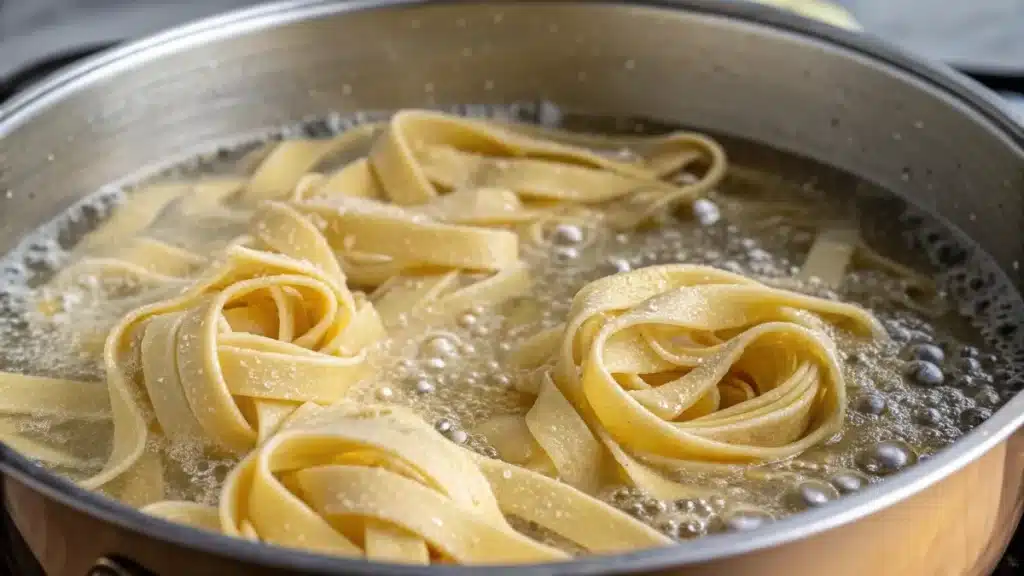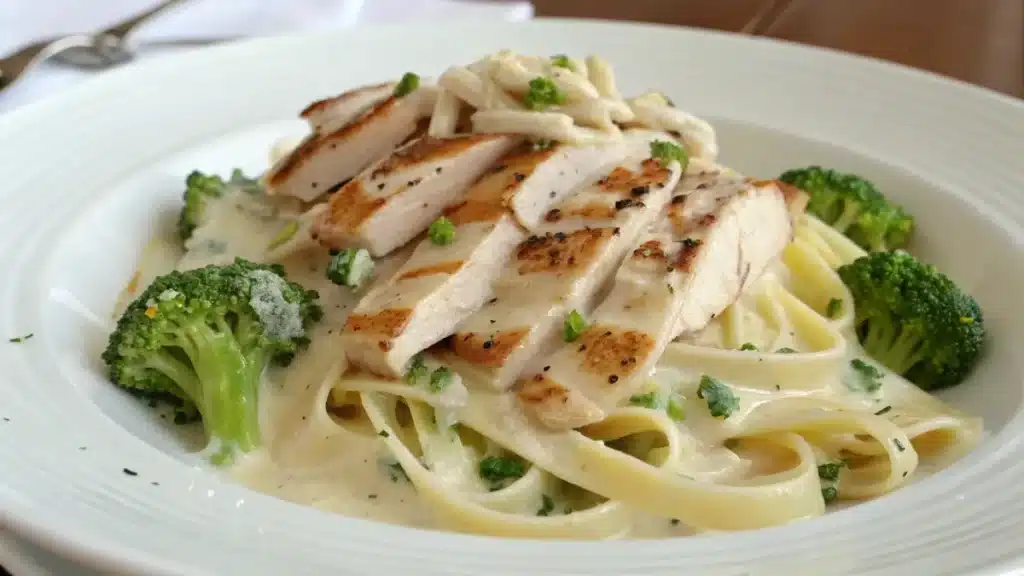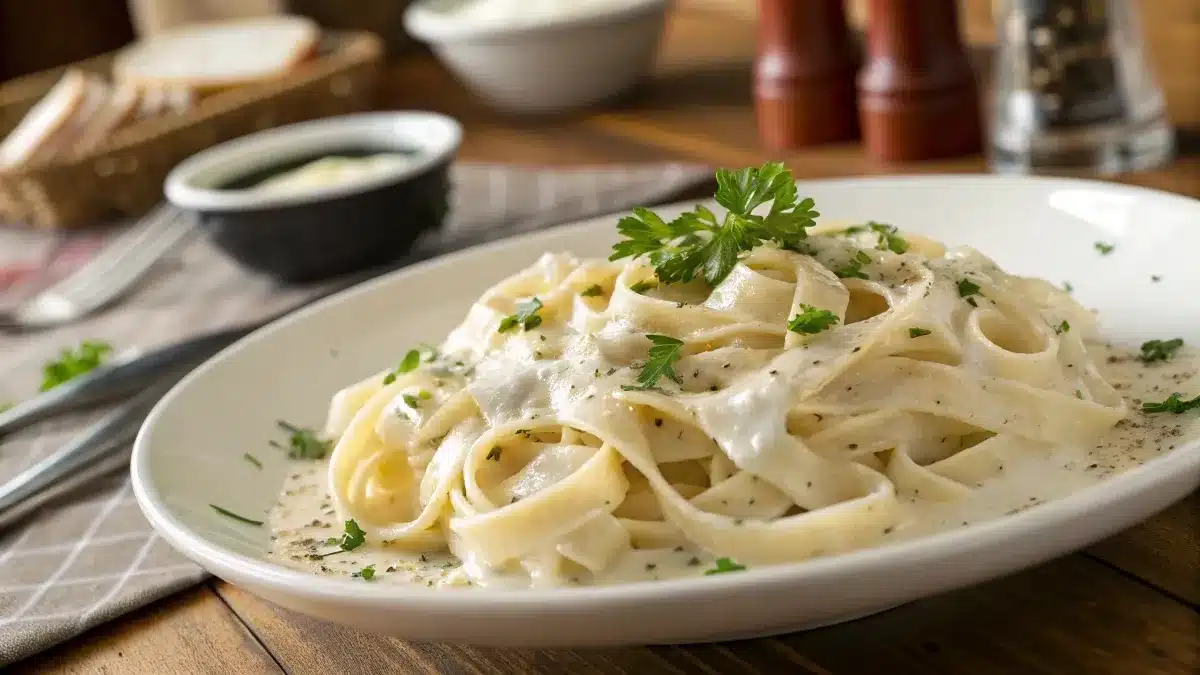Gluten Free Fettuccine Alfredo: The Ultimate Guide to a Creamy Classic
When it comes to comfort food that’s rich, creamy, and satisfying, few dishes can beat a steaming plate of fettuccine Alfredo. But what if you’re avoiding gluten? Don’t worry — this ultimate guide to gluten free fettuccine alfredo has got you covered! From picking the best gluten free noodles to mastering a smooth Alfredo sauce without flour, we’ll break it all down. We’ll also tackle common challenges like stopping gluten-free pasta from sticking and making sure your sauce stays creamy. Whether you’re making it from scratch or looking for store-bought options, you’ll find everything you need right here. Looking for inspiration? Try Chicken Ricotta Meatballs with Spinach Alfredo Sauce to pair with your pasta.
Table of Contents
Understanding Gluten Free Fettuccine Alfredo
What Makes Fettuccine Alfredo Gluten Free?
Gluten free fettuccine Alfredo starts with one key swap: the pasta. Traditional fettuccine is made from wheat flour, which contains gluten — a protein that can trigger digestive issues or more serious reactions in people with celiac disease or gluten sensitivity. To make this dish gluten free, you’ll want pasta made from alternatives like rice flour, corn flour, quinoa, or chickpeas.
Another element to consider is the Alfredo sauce. Classic Alfredo is traditionally made with butter, cream, and Parmesan, which are naturally gluten free. But if you’re buying pre-made sauces, always check the label! Some brands add thickeners or flavorings that could contain gluten.
Discover great ideas like Gluten-Free Soft Pretzels for another celiac-safe treat.
The Benefits of Choosing Gluten Free Pasta Options
Choosing gluten free pasta isn’t just for those with celiac disease. Many people find that gluten free options are easier to digest and less likely to cause bloating. Pasta made from rice, corn, or legumes can offer more fiber, protein, or even added nutrients depending on the blend. Plus, with so many tasty brands on the market, you won’t feel like you’re missing out on texture or flavor.
Check out Pillsbury Gluten Free Flour for baking needs that complement your pasta dishes. Don’t miss our Gluten Free King Cake if you’re planning a full gluten free meal spread!
Key Ingredients for the Best Gluten Free Alfredo
Gluten Free Fettuccine Noodles: Top Brands and Choices
Choosing the right pasta is the first step to a successful gluten free fettuccine Alfredo. Not all gluten free noodles are created equal — some hold up beautifully to creamy sauces, while others can turn mushy fast.
Here’s a handy table comparing some popular gluten free fettuccine brands:
| Brand | Main Ingredients | Texture When Cooked | Notes |
|---|---|---|---|
| Barilla Gluten Free | Corn, rice | Firm, holds sauce well | Widely available |
| Jovial Foods | Brown rice | Smooth, al dente | Organic, clean ingredients |
| Tinkyada | Brown rice | Slightly chewy | Great for reheating |
| Banza | Chickpeas | High-protein, nutty | May break if overcooked |
Pro tip: Always follow the cooking time on the package, and test for doneness early. Overcooked gluten free pasta can fall apart easily!
Don’t miss our Chicken Ricotta Meatballs with Spinach Alfredo Sauce as a delicious topping for your pasta.
How to Select Gluten Free Alfredo Sauce (Are Any Alfredo Sauces Gluten Free?)
Now, let’s talk sauce. Many store-bought Alfredo sauces can be gluten free, but it’s essential to read the labels carefully. Look for certifications or clear statements like “gluten free” to be sure. Here are some common ingredients to watch out for:
- Modified food starch (may contain gluten unless specified)
- Maltodextrin (safe in the USA, but double-check)
- Artificial thickeners or flavorings
Trusted gluten free Alfredo sauce brands:
- Rao’s Homemade Alfredo Sauce
- Classico Creamy Alfredo (some varieties are gluten free)
- Primal Kitchen Dairy-Free Alfredo
Making it at home? You can control every ingredient and skip the worry. A classic homemade Alfredo sauce with butter, heavy cream, and Parmesan is naturally gluten free — no hidden additives.
Learn more about gluten free flours and blends at Pillsbury Gluten Free Flour.
How to Make Gluten Free Fettuccine Alfredo at Home

Step-by-Step Recipe for Homemade Gluten Free Alfredo Sauce
Nothing beats the fresh, rich taste of a homemade gluten free fettuccine Alfredo sauce. The best part? You don’t need flour at all to achieve that silky texture! Here’s a simple recipe that’s naturally gluten free:
Ingredients:
- 1 cup heavy cream
- 4 tablespoons unsalted butter
- 1 cup grated Parmesan cheese (use a block, not pre-shredded for best melt)
- 2 garlic cloves, minced (optional for extra flavor)
- Salt and pepper to taste
- Pinch of nutmeg (optional)
Instructions:
- Melt the butter in a large skillet set over medium heat.
- Stir in the garlic and sauté for about a minute, until it’s aromatic.
- Slowly add the heavy cream, stirring often, and bring it to a light simmer.
- Whisk in the Parmesan cheese little by little, stirring until it melts completely and the sauce is smooth.
- Add salt, pepper, and a pinch of nutmeg to season the sauce.
- Combine with your cooked gluten-free fettuccine, toss well, and serve right away.
Looking for inspiration? Try pairing it with Chicken Ricotta Meatballs with Spinach Alfredo Sauce.
What Can I Use Instead of Flour in Alfredo Sauce?
Traditional Alfredo sauce doesn’t require flour, but if you want extra thickness or you’re making a lighter version, here are gluten free options:
- Cornstarch slurry: Mix 1 teaspoon cornstarch with 2 tablespoons cold water and whisk into your sauce.
- Gluten free flour blends: A teaspoon added early can thicken the sauce — try blends like Pillsbury Gluten Free Flour.
- Cream cheese: Adds body and richness without flour.
When thickening, add small amounts at a time so your sauce doesn’t turn gummy.
Check out Gluten-Free Soft Pretzels for a fun side to your pasta night.
Quick Tip Table: Flour Alternatives
| Thickener | Gluten Free? | Best For |
|---|---|---|
| Cornstarch slurry | Yes | Light thickening |
| Cream cheese | Yes | Extra creamy texture |
| Xanthan gum | Yes | Minimal use, powerful thickener |
| Gluten free flour | Yes | Traditional thickening, small amounts |
Cooking Tips for Perfect Gluten Free Pasta

The Trick to Cooking Gluten Free Pasta Without Mushiness
Cooking gluten free pasta like fettuccine requires a bit of care to avoid that dreaded mushy texture. The key? Watch the clock — gluten free noodles tend to go from perfect to overcooked fast!
Here’s how to get it right:
- Use plenty of water: A large pot gives the pasta space to move and prevents clumping.
- Salt the water well: This boosts flavor and helps firm up the pasta’s structure.
- Stir often: Gluten free fettuccine can stick together easily, so give it a gentle stir every couple of minutes.
- Test early: Start testing for doneness 2 minutes before the package suggests. Aim for firm but cooked-through pasta that can hold the creamy Alfredo sauce.
Discover great ideas like Gluten-Free King Cake to round out your gluten free dinner party.
How to Stop Gluten-Free Pasta from Sticking Together
We’ve all been there — your pasta looks great in the pot, but by the time it hits the plate, it’s one big clump. Here’s how to stop that:
- Don’t over-drain: A little pasta water on the noodles helps keep them separate.
- Toss immediately with sauce or a touch of olive oil: Gluten free fettuccine tends to stick as it cools. Coating it keeps the strands loose.
- Serve right away: Gluten free pasta doesn’t hold as well when left sitting.
Learn more about gluten free flour alternatives in recipes like Pillsbury Gluten Free Flour.
Here’s a quick reference table for pasta cooking success:
| Tip | Why It Helps |
|---|---|
| Large pot of water | Prevents clumping |
| Frequent stirring | Separates noodles |
| Early testing | Avoids mushiness |
| Quick saucing | Stops sticking |
Restaurant and Store-Bought Options
Is Olive Garden Alfredo Gluten Free?
Many fans of fettuccine Alfredo wonder whether they can enjoy this creamy classic at popular chain restaurants like Olive Garden while staying gluten free. Olive Garden does offer a gluten sensitive menu, but it’s important to note that their Alfredo sauce isn’t guaranteed gluten free due to potential cross-contact in shared kitchen spaces.
Here’s the key takeaway:
- Alfredo sauce at Olive Garden may contain trace gluten from shared equipment or prep surfaces.
- Even with their gluten sensitive pasta options (such as rotini), the risk of cross-contact is present.
If you’re highly sensitive or have celiac disease, it’s best to skip Alfredo at Olive Garden or ask detailed questions about kitchen practices. Many diners prefer making their own gluten free fettuccine Alfredo at home to ensure safety.
Best Gluten Free Alfredo Products at Grocery Stores
If you don’t want to make Alfredo sauce from scratch, there are plenty of delicious gluten free jarred options out there. Just remember — always double-check the label to confirm gluten free status!
Here are some top picks:
| Brand | Key Features | Gluten Free Certified? |
|---|---|---|
| Rao’s Homemade Alfredo Sauce | Simple ingredients, rich flavor | Yes |
| Primal Kitchen Alfredo | Dairy-free, paleo-friendly | Yes |
| Classico Creamy Alfredo (some varieties) | Affordable, widely available | Check label |
| Victoria Alfredo Sauce | Non-GMO, clean label | Yes |
Don’t miss our Chicken Ricotta Meatballs with Spinach Alfredo Sauce for a tasty topping on store-bought pasta.
When it comes to noodles, look for pasta made from rice, corn, quinoa, or chickpeas. Banza, Jovial, and Barilla all offer gluten free fettuccine options that pair beautifully with Alfredo sauce.
Looking for inspiration? Try serving with Gluten-Free Soft Pretzels as a fun side.
Pairing Ideas and Serving Suggestions
Tasty Sides That Complement Gluten Free Fettuccine Alfredo
A creamy plate of gluten free fettuccine Alfredo is delicious on its own, but adding the right sides can elevate your meal from good to unforgettable. Since Alfredo is rich and velvety, choose sides that balance out the flavors.
Here are some perfect pairings:
- Gluten free garlic bread: Made with gluten free baguettes or sandwich bread, toasted with butter, garlic, and parsley.
- Simple green salad: Fresh greens with a light vinaigrette cut through the richness of Alfredo. Discover great ideas like Gluten-Free King Cake if you’re planning a full gluten free spread.
- Roasted veggies: like broccoli, asparagus, or Brussels sprouts add vibrant color and a satisfying crunch.
- Gluten free soft pretzels: A fun, chewy side that pairs surprisingly well. Check out Gluten-Free Soft Pretzels.

Creative Twists: Adding Chicken, Shrimp, or Veggies
Want to turn your gluten free fettuccine Alfredo into a full meal? Add protein or extra veggies right to the pasta for a one-bowl wonder.
Here are easy ideas:
- Chicken Alfredo: Grilled or pan-seared chicken breast sliced over the pasta. Or, don’t miss our Chicken Ricotta Meatballs with Spinach Alfredo Sauce — it’s a perfect topping.
- Shrimp Alfredo: Quick-cooking shrimp bring a seafood twist. Sauté in garlic butter for added flavor.
- Veggie Alfredo: Stir in steamed broccoli, mushrooms, or spinach for a nutrient boost and added texture.
Looking for inspiration? Try using Pillsbury Gluten Free Flour to make your own gluten free breadsticks.
Here’s a quick pairing guide:
| Add-In | Why It Works |
|---|---|
| Chicken | Adds lean protein and flavor balance |
| Shrimp | A touch of elegance and lightness |
| Broccoli | Brightens the dish with color and crunch |
| Mushrooms | Deep, earthy flavor pairs well with cream |
Common Mistakes to Avoid
Why Your Gluten Free Alfredo Might Not Turn Out Creamy
Ever ended up with a watery or grainy Alfredo sauce? It happens, but a few simple tweaks can help you nail that perfect creamy texture every time — even with gluten free fettuccine Alfredo.
Here’s what to watch for:
- Overheating the sauce: Alfredo sauce can break if you cook it on high heat. Keep it on low or medium and stir often.
- Pre-shredded Parmesan: These often contain anti-caking agents that prevent smooth melting. Always use fresh, finely grated Parmesan.
- Skipping the simmer: Let your sauce simmer gently to reduce and thicken naturally.
If you’re using a thickener, go easy. A cornstarch slurry or small amount of gluten free flour (like Pillsbury Gluten Free Flour) works, but too much can make the sauce gummy.
Can You Cook Gluten-Free Pasta in the Same Water as Regular Pasta?
This is a crucial question, especially for people with celiac disease or severe gluten sensitivity. The short answer? No.
Here’s why:
- Cross-contact risk: Even trace amounts of gluten left in pasta water can contaminate gluten free pasta.
- Shared utensils: Be mindful of strainers, spoons, and pots. If they’ve touched wheat pasta, wash them thoroughly before using for gluten free cooking.
When cooking both types of pasta for a mixed crowd, always use separate pots and tools to keep your gluten free fettuccine Alfredo safe.
Learn more about gluten free sides like Gluten-Free King Cake to round out your meal.
Here’s a quick no-mistakes checklist:
| Mistake | Solution |
|---|---|
| Overheating sauce | Use low to medium heat |
| Pre-shredded cheese | Use fresh, grated Parmesan |
| Cooking in shared water | Always use a separate pot |
| Over-thickening | Add thickeners slowly |
Storage and Meal Prep Tips
How to Store Leftover Gluten Free Fettuccine Alfredo
Made a little too much? No worries. While creamy pasta dishes can be tricky to store, there are easy ways to keep your gluten free fettuccine Alfredo fresh and flavorful.
Storage tips for best results:
- Let it cool completely before refrigerating to avoid condensation and soggy noodles.
- Store in an airtight container, and if possible, separate the pasta from the sauce for better texture.
- Refrigerate for up to 3 days. Gluten free pasta doesn’t last quite as long as regular wheat pasta, so enjoy your leftovers sooner rather than later.
For sauces made with fresh dairy (like cream or cheese), don’t leave them sitting at room temperature for long — bacteria can grow fast.
Don’t miss our Chicken Ricotta Meatballs with Spinach Alfredo Sauce for easy next-day meal ideas using your leftovers.
Freezing and Reheating Without Compromising Texture
Can you freeze gluten free fettuccine Alfredo? Yes — but with some caveats. Here’s how to do it right:
Freezing Tips:
- Freeze the sauce separately if possible. Pasta texture can become grainy or fall apart after thawing.
- Use freezer-safe bags or containers and remove as much air as you can.
- Label clearly with the date and use within 1–2 months for best flavor.
Reheating Tips:
- Reheat gently on the stove over low heat, stirring constantly. Stir in a bit of milk or broth to refresh and loosen up the sauce.
- If reheating from frozen, thaw in the refrigerator overnight first.
- Try to skip the microwave—it can cause the sauce to break and the pasta to turn rubbery.
Here’s a quick guide for reference:
| Storage Method | How Long? | Notes |
|---|---|---|
| Refrigerator | 3 days | Best if stored separately |
| Freezer | 1–2 months | Sauce freezes better than pasta |
| Reheating | On stovetop | Add liquid to revive creaminess |
Nutrition and Allergen Information
Caloric and Nutritional Breakdown of Gluten Free Fettuccine Alfredo
When you’re enjoying a plate of gluten free fettuccine Alfredo, it’s good to know what you’re eating — especially if you’re tracking calories or macros. Here’s an approximate breakdown per serving (about 1 1/2 cups) for a classic version made with cream, butter, Parmesan, and gluten free fettuccine:
| Nutrient | Amount |
|---|---|
| Calories | 550–650 kcal |
| Protein | 18–22 g |
| Carbs | 45–50 g |
| Fat | 35–40 g |
| Fiber | 2–4 g (depending on pasta type) |
| Sodium | 600–800 mg |
Remember: gluten free fettuccine made from chickpeas or quinoa will generally have more fiber and protein than rice or corn pasta.
Looking for inspiration? Try Pillsbury Gluten Free Flour in homemade breadsticks to pair with your pasta.
Dairy-Free and Vegan Alfredo Variations
If you’re also avoiding dairy or want a plant-based alternative, there are plenty of ways to enjoy gluten free fettuccine Alfredo. Here are some simple swaps:
- Coconut cream or cashew cream instead of heavy cream — both give a rich, silky base.
- Swap in nutritional yeast to get a cheesy taste without using Parmesan.
- Olive oil or vegan butter in place of regular butter.
You can also find store-bought vegan Alfredo sauces that are gluten free, like Primal Kitchen’s dairy-free Alfredo or Daiya Alfredo-style sauce.
Here’s a quick comparison of classic vs. vegan Alfredo:
| Ingredient | Classic Alfredo | Vegan/Dairy-Free Alfredo |
|---|---|---|
| Cream | Heavy cream | Coconut or cashew cream |
| Cheese | Parmesan | Nutritional yeast |
| Butter | Unsalted butter | Olive oil or vegan butter |
Check out Gluten-Free King Cake for a dessert that fits into your gluten free lifestyle.
Conclusion
Making a mouthwatering gluten free fettuccine Alfredo is absolutely achievable — and delicious! From picking the right noodles and sauce to mastering cooking techniques, you can enjoy this creamy classic without worry. Whether you opt for homemade Alfredo or a trusted store-bought jar, the key is reading labels, using separate cooking tools, and adding your own twist with chicken, shrimp, or veggies.
Check out Gluten-Free Soft Pretzels for a fun side dish, and don’t miss our Chicken Ricotta Meatballs with Spinach Alfredo Sauce for extra protein.
FAQs
Are any Alfredo sauces gluten free?
Yes, many Alfredo sauces are naturally gluten free because traditional recipes use cream, butter, and Parmesan — none of which contain gluten. However, when buying jarred sauces, it’s crucial to read the labels. Look for brands like Rao’s, Primal Kitchen, or Victoria that are certified gluten free to avoid hidden thickeners or additives that may contain gluten.
What can I use instead of flour in Alfredo?
You don’t need flour for a rich Alfredo sauce. Traditional recipes thicken naturally with cream and cheese. If you want extra body, try cornstarch slurry, cream cheese, or a teaspoon of gluten free flour like Pillsbury Gluten Free Flour.
Is Olive Garden Alfredo gluten free?
Olive Garden’s Alfredo sauce may not be safe for those with celiac disease or severe gluten sensitivity due to possible cross-contact in their kitchens. While they offer a gluten sensitive menu, the shared prep environment means trace gluten could still be present.
What is the trick to cooking gluten free pasta?
The trick is to use plenty of water, stir often, and test early — about 2 minutes before the package time. Gluten free pasta can overcook quickly, so keep a close eye and serve immediately with your Alfredo sauce.
How to stop gluten-free pasta from sticking?
Don’t over-drain — leave a little pasta water on the noodles. Toss with sauce or a bit of olive oil right away, and serve hot. Gluten-free pasta can stick together as it cools, so serving it promptly is important.
Can you cook gluten-free pasta in the same water as regular pasta?
No. To avoid cross-contact, always cook gluten free pasta in a separate pot. Even small amounts of gluten from shared water can make a dish unsafe for people with celiac disease.

